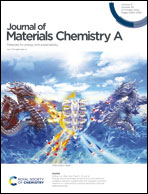Dual-defect site regulation on MOF-derived P-Co3O4@NC@Ov-NiMnLDH carbon arrays for high-performance supercapacitors†
Abstract
Introducing oxygen vacancies into hydrotalcite-like materials is considered to have positive effects on improving their electrochemical properties. However, there are still huge challenges to fully utilize the effect of exposed surface defects due to the instability in the electron transfer process. Herein, a dual-defect modulated MOF-derived P-Co3O4@NC@Ov-NiMnLDH heterostructure synthesized via the strategy of P doping and vacancy engineering is proposed in this paper, which can take advantage of synergistic defects to realize high-performance features of supercapacitors and avoid the possible deficiencies caused by single defects. A remarkable specific capacity of the optimized electrode at 1 A g−1 is 285.56 mA h g−1. Moreover, the assembled ASC MOF-derived P-Co3O4@NC@Ov-NiMnLDH//CNT@ZIF-8 derived C delivers an excellent specific capacitance of 61.33 mA h g−1 (1 A g−1), a superior capacity retention rate of 91.92% after 12 000 cycles and additionally, an energy density of up to 49.06 W h kg−1 at a power density of 800 W kg−1. The dual-defect modulated electrode can provide new design ideas for superior-performance energy storage materials.



 Please wait while we load your content...
Please wait while we load your content...